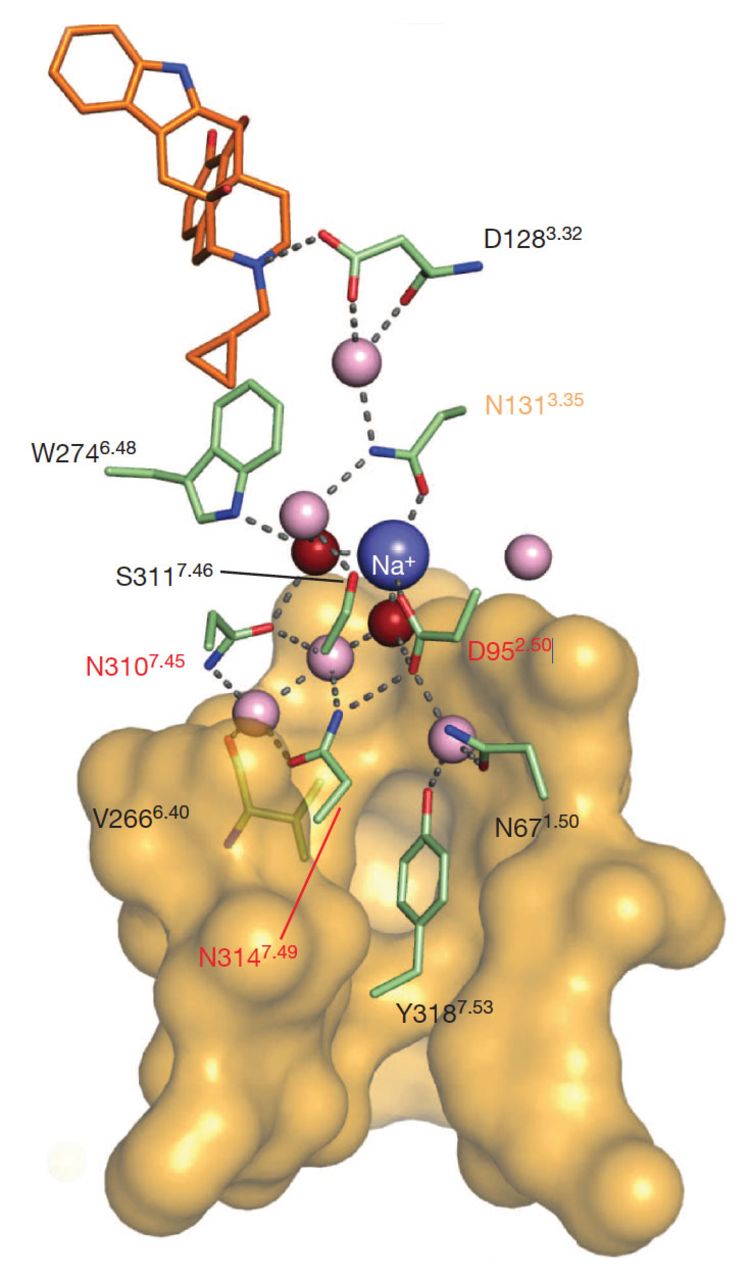Bryan Roth and collaborator Raymond Stevens’ Nature paper on “Molecular control of δ-opioid receptor signalling” was selected as one of the Best Breakthroughs in Signaling in 2014 in the Jan. 6 issue of Science Signaling. Gustavo Fenalti was first author on the paper.

The Nature paper by the Roth and Stevens Labs, Fenalti et al., “Molecular control of δ-opioid receptor signalling” made the Breakthroughs list by showing how constituents of our diet affect our physiology.
Henrik Dohlman, contributor to the Breakthroughs article, noted that the crystal structures in this paper “provide a detailed picture of protein ‘sensors’ for physiological sodium and chloride” that may illustrate the mechanisms underlying the “connection between the consumption of table salt (sodium chloride) and hypertension.” Fenalti et al. (13) discovered a partially hydrated sodium ion in the middle of the seven-transmembrane domains of the δ-opioid receptor (Fig. 3) reminiscent of several other class A G protein–coupled receptors. The sodium ion allosterically modifies the binding of a peptide agonist to the δ-opioid receptor, producing the “sodium effect” that has been used to differentiate opioid agonists from antagonists. The bound sodium ion also determines whether the receptor signals through Gαi or β-arrestin.
Fig. 3: The seven-transmembrane domains of the δ-opioid receptor contain a sodium ion.
The crystal structure of a fusion protein containing residues 36-338 of the human δ-opioid receptor in complex with the ligand naltrindole was obtained at 1.8 Å resolution. The sodium ion is shown as a blue sphere; water molecules are shown as red and pink spheres; hydrophobic residues are shown as the orange surface; naltrindole is shown as orange sticks; and hydrogen bonds are shown as dashed lines. CREDIT: REPRINTED BY PERMISSION FROM MACMILLAN PUBLISHERS LTD: NATURE 506, 191–196, © 2014
(~The above excepted from Science Signaling 2014: Signaling Breakthroughs of the Year” by Jason D. Berndt and Wei Wong, Jan. 6, 2015 issue.)
Read the full article in Science Signaling: “2014: Signaling Breakthroughs of the Year”
Berndt JD, Wong W. 2014: signaling breakthroughs of the year. Sci Signal. 2015 Jan 6;8(358):eg1. doi: 10.1126/scisignal.aaa4696. PubMed PMID: 25564676.
Read the Fenalti et al. Nature paper, “Molecular control of δ-opioid receptor signalling”
Fenalti G, Giguere PM, Katritch V, Huang XP, Thompson AA, Cherezov V, Roth BL, Stevens RC. Molecular control of δ-opioid receptor signalling. Nature. 2014 Feb 13;506(7487):191-6. doi: 10.1038/nature12944.
